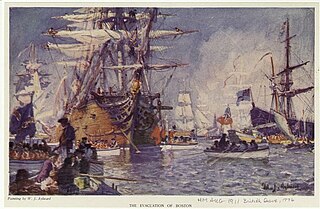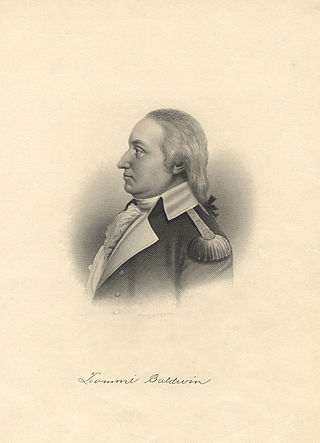
The siege of Boston was the opening phase of the American Revolutionary War. In the siege, American patriot militia led by newly-installed Continental Army commander George Washington prevented the British Army, which was garrisoned in Boston, from moving by land. Both sides faced resource, supply, and personnel challenges during the siege. British resupply and reinforcement was limited to sea access, which was impeded by American vessels. The British ultimately abandoned Boston after eleven months, moving their troops and equipment north, to Nova Scotia.
Ebenezer Learned was a brigadier general in the American Continental Army during the Revolutionary War.

Deborah Sampson Gannett, also known as Deborah Samson or Deborah Sampson, was born on December 17, 1760, in Plympton, Massachusetts. She disguised herself as a man, and served in the Continental Army under the name Robert Shirtliff – sometimes spelled Shurtleff or Shirtleff – and fought in the American Revolutionary War. She fought in the war for 17 months before her sex was revealed when she required medical treatment after contracting a fever in Philadelphia in 1783. After her real identity was made known to her commander, she was honorably discharged at West Point. After her discharge, Sampson met and married Benjamin Gannett in 1785. In 1802, she became one of the first women to go on a lecture tour to speak about her wartime experiences. She died in Sharon, Massachusetts, in 1827. She was proclaimed the Official Heroine of the Commonwealth of Massachusetts on May 23, 1983, and in 1985 the United States Capitol Historical Society posthumously honored "Deborah Samson" with the Commemorative Medal.

The Battle of White Plains was a battle in the New York and New Jersey campaign of the American Revolutionary War, fought on October 28, 1776, near White Plains, New York. Following the retreat of George Washington's Continental Army northward from New York City, British General William Howe landed troops in Westchester County, intending to cut off Washington's escape route. Alerted to this move, Washington retreated farther, establishing a position in the village of White Plains but failing to establish firm control over local high ground. Howe's troops drove Washington's troops from a hill near the village; following this loss, Washington ordered the Americans to retreat farther north.

John Paterson was a major general in the Continental Army during the American Revolution, and a U.S. Congressman from New York.
The 2nd Massachusetts Regiment, also known as Thomas' Regiment and Bailey's Regiment, was a unit of the Massachusetts Line in the 1777 establishment of the Continental Army. It was a successor to a number of Massachusetts provincial regiments from the army's 1775 establishment, and was known as the 23rd Continental Regiment during the 1776 establishment. It was raised on April 23, 1775, under Colonel John Thomas outside of Boston, Massachusetts; the commanding officer for much of its existence was Colonel John Bailey. The regiment would see action at the Battle of Bunker Hill, New York Campaign, Battle of Trenton, Battle of Princeton, Battle of Saratoga and the Battle of Monmouth. The regiment was also encamped during the winter of 1777–1778 at Valley Forge. The regiment was disbanded on November 3, 1783, at West Point, New York.
The 3rd Massachusetts Regiment also known as the 24th Continental Regiment, Heath's Regiment, and Greaton's Regiment, was raised on April 23, 1775, under Colonel William Heath outside Boston, Massachusetts. When Heath was promoted to brigadier general in June 1775 the regiment came under the command of Colonel John Greaton. The regiment would see action at the Battle of Bunker Hill, Battle of Trois-Rivières, Battle of Valcour Island and the Battle of Saratoga. The regiment was disbanded, on November 3, 1783, at West Point, New York. Lineage carried on by the U.S. 104th Infantry Regiment.
The 8th Massachusetts Regiment also known as 16th Continental Regiment and Sargent's Regiment, was raised on April 23, 1775, under Colonel Paul Dudley Sargent at Cambridge, Massachusetts. The regiment would see action at the Battle of Bunker Hill, New York and New Jersey Campaign, Battle of Trenton, Battle of Princeton and the Battle of Saratoga. The regiment was furloughed June 12, 1783, at West Point, New York and disbanded on November 3, 1783.
The 10th Massachusetts Regiment was a military regiment in the American Revolutionary War. It was authorized on 16 September 1776, in the Continental Army under Colonel Marshall at Boston, Massachusetts, as eight companies of volunteers from Worcester, Middlesex, Essex, Bristol, Hampshire, Plymouth, and Suffolk counties of the colony of Massachusetts and Cheshire county of the colony of New Hampshire. On 13 August 1777, the regiment was assigned to 3d Massachusetts Brigade in the Northern Department. The brigade was reassigned to the main Continental Army on 27 October 1777. On 20 November 1778, the brigade was reassigned to the Highland's Department and on 12 May 1779 was re-organized to nine companies. On 1 January 1781, the regiment was reassigned to the 1st Massachusetts Brigade of the Highland's Department. On 18 June 1781, the regiment was reassigned to the New Hampshire Brigade. This brigade was reassigned from the Highland's Department to the Northern Department on 14 October 1781. The regiment was relieved from this brigade on 12 November 1781 and assigned to the Highland's Department. On 29 August 1782, the regiment was assigned to the New Hampshire Brigade in the Northern Department. It was relieved from this brigade on 26 October 1782 and assigned to the Highland's Department. The regiment was disbanded on 15 November 1783 at West Point, New York. The regiment would see action at the Battle of Saratoga and the Battle of Monmouth.
The 13th Massachusetts Regiment, also known as the 6th Continental Regiment and Jonathan Brewer's Regiment, was first raised in 1775 by Colonel Jonathan Brewer. Under Colonel Edward Wigglesworth in 1776 it was designated the 6th Continental. It was manned with troops raised primarily from Essex, York, and Cumberland Counties. An additional battalion was later raised from Middlesex, Suffolk, Plymouth and Barnstable Counties. The regiment would see action at the Battle of Bunker Hill, Battle of Valcour Island, Battle of Saratoga, Battle of Monmouth and the Battle of Rhode Island. The regiment was disbanded on January 1, 1781, at West Point, New York. The Light Infantry Company fought at the Battle of Stony Point
The 15th Massachusetts Regiment was raised on September 16, 1776, under Colonel Timothy Bigelow at Boston, Massachusetts, as part of Massachusetts contribution to the Resolve of 88 Regiments. The regiment would see action at the Battle of Saratoga, Battle of Monmouth and the Battle of Rhode Island. The regiment was disbanded on January 1, 1781, at West Point, New York.
The 16th Massachusetts Regiment, also known as Henry Jackson's Additional Continental Regiment, was a unit of the American Massachusetts Line, raised on January 12, 1777, under Colonel Henry Jackson at Boston, Massachusetts. The regiment would see action at the Battle of Monmouth and the Battle of Rhode Island. The regiment was disbanded on January 1, 1781, at New Windsor, New York.
Evans' Regiment of Militia also known as the 4th New Hampshire Militia Regiment was called up at Exeter, New Hampshire on September 8, 1777 as reinforcements for the Continental Army during the Saratoga Campaign. The regiment marched quickly to join the gathering forces of General Horatio Gates as he faced British General John Burgoyne in northern New York. The regiment served in General Ebenezer Learned's brigade of the Continental Army. With the surrender of Burgoyne's Army on October 17 the regiment was disbanded on December 15, 1777. The Regiment was called up again as part of Gen. John Sullivan's army at the unsuccessful Battle of Rhode Island in 1778.

The Massachusetts Line was those units within the Continental Army that were assigned to Massachusetts at various times by the Continental Congress during the American Revolutionary War. These, together with similar contingents from the other twelve states, formed the Continental Line. Line regiments were assigned to a particular state, which was then financially responsible for the maintenance of the regiment. The concept of the line was also particularly important in relation to the promotion of commissioned officers. Officers of the Continental Army below the rank of brigadier general were ordinarily ineligible for promotion except in the line of their own state.
The northern theater of the American Revolutionary War also known as the Northern Department of the Continental Army was a theater of operations during the American Revolutionary War.

The 26th Continental Regiment was an infantry unit of the Massachusetts Line during the American Revolutionary War. Gerrish's Regiment was raised in the early days of the war, and the regiment underwent name changes as the Continental Army was reorganized in 1776 and 1777. From 1777 onward, the unit was known as the 9th Massachusetts Regiment.





